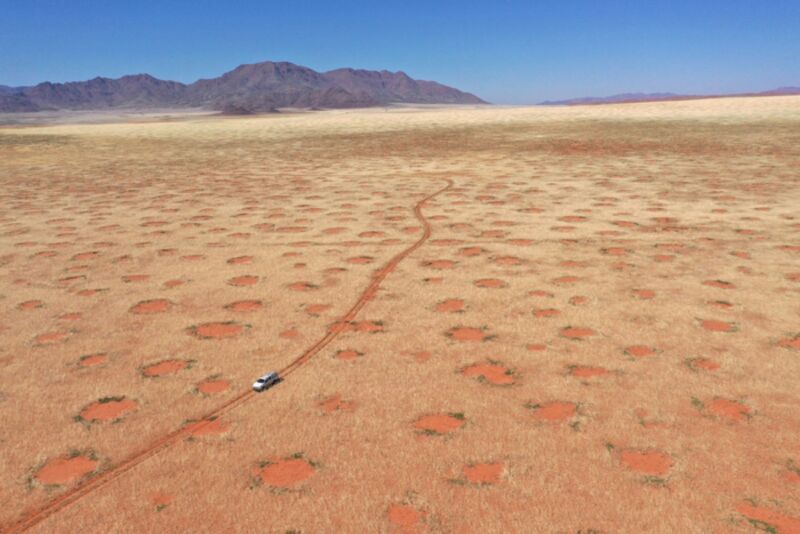
Stephan Getzin
So-called “fairy circles” are bare, reddish-tinged circular patches found mainly in the Namibian grasslands and northwestern Australia. Scientists have long debated whether these unusual patterns are due to termites or to an ecological version of a self-organizing Turing mechanism. A few years ago, Stephan Getzin of the University of Göttingen found strong evidence for the latter hypothesis in Australia. And now his team has found similar evidence in Namibia, according to a new paper published in the journal Perspectives in Plant Ecology, Evolution and Systematics.
“We can now definitively reject the termite hypothesis, as the termites are not a requirement to form new fairy circles,” Getzin told Ars. This applies to both Australian and Namibian fairy circles.
As we previously reported, the Himba bushmen in the Namibian grasslands have passed down legends about the region’s mysterious fairy circles. They can be as large as several meters in diameter. Also called “footprints of the gods”, they are often said to be the work of the Himba god Mukuru, or an underground dragon whose poisonous breath kills everything that grows in those circles.
Scientists have their own ideas, and over the years two different hypotheses have emerged about how the circles form. One theory attributed the phenomenon to a particular species of termites (Psammmotermes allocerus), the digging of which damages the plant roots, allowing extra rainwater to seep into the sandy soil before the plants can soak it up, providing the termites with a handy water trap as a resource. As a result, the plants die back in a circle from the site of an insect nest. The circles increase in diameter during drought, as the termites have to go further out to find food.
The other hypothesis – Getzin’s – posits that the circles are a kind of self-organized spatial growth pattern (a Turing pattern) that arises when plants compete for scarce water and soil nutrients. In his seminal 1952 paper, Alan Turing sought to understand how natural, non-random patterns arise (like a zebra’s stripes), and he focused on chemicals known as morphogens. He designed a mechanism that involves the interaction between an activating chemical and an inhibitory chemical that diffuse through a system, much like gas atoms do in a sealed box.
It is similar to injecting a drop of black ink into a cup of water. Normally this would stabilize a system: the water would gradually turn an even gray. But if the inhibitor diffuses faster than the activator, the process is destabilized. That mechanism will produce a Turing pattern: spots, stripes or, when applied to an ecological system, clusters of ant nests or fairy circles.
A researcher investigates the death of grasses in fairy circles on a plot near Kamberg in the Namib. The image was taken about a week after rainfall in March 2020.
In 2019, Getzin’s team conducted a study of fairy circles in northwestern Australia, near an old mining town called Newman. The team dug more than 150 holes in nearly 50 fairy circles in the region to collect and analyze soil samples, specifically to test the termite hypothesis. They also used drones to map larger areas of the continent to compare the holes in the vegetation typically caused by termites in the region, with the fairy circles that sometimes form.
The holes in the vegetation caused by the harvester termites were only about half the size of the fairy circles and much less orderly, so they found no hard underground termitaria that would hinder the growth of grasses. But they did find high soil compaction and clay content in the circles, evidence of the contribution of heavy rainfall, extreme heat and evaporation to their formation. “Termite structures may occur in the area of the fairy circles, but the partial local correlation between termites and fairy circles has no causation,” Getzin said at the time. “So no destructive mechanisms, like those of termites, are needed for the formation of the various fairy circle patterns; hydrological plant-soil interactions alone are sufficient.”
After effectively disproving the Australian termite hypothesis, Getzin turned his attention to testing the termite hypothesis specifically for Namibia, using a similar methodology. While his previous work on Namibian fairy circles didn’t specifically address plant root research, this new study shows that plant roots are not touched by insect herbivores.
Investigating a fairy circle in Brandberg in Namibia 35 days after rainfall in March 2021.
“For the first time, we went to the fairy circles immediately after rainfall and checked the new grasses for termite herbivore,” Getzin told Ars. “Our excavations show that termites certainly didn’t cause the deaths of the grasses. If you get to the fairy circles too late, the grasses are long dead and detritivores such as termites may have already fed on the lignified grass. But they have the We show unequivocally that the grasses die earlier and are completely independent of any termite action.”
So what’s next for Getzin? He believes more research is needed on plant swarm intelligence, comparing plants to beavers in that they can act as “ecosystem engineers” modifying their environment. “Most people can’t or don’t want to believe this because plants don’t have brains,” Getzin says. “But plants behave similarly to the beaver as ecosystem engineers, because their only way to survive is to form optimal, strictly geometric patterns,” in other words, Turing patterns.
DOI: Perspectives in Plant Ecology, Evolution and Systematics, 2022. 10.1016/j.ppees.2022.125698 (About DOIs).

